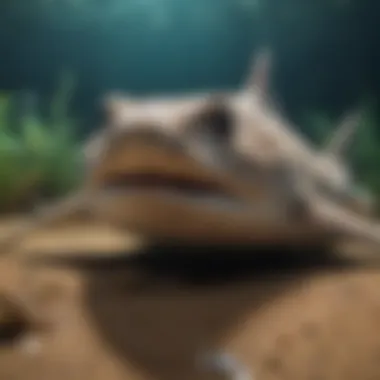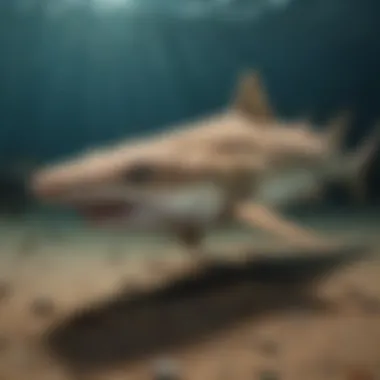Understanding the Endangered Status of the Angel Shark: Causes and Conservation Efforts


Animal Species Profile
- Introduction to the animal species
The angel shark, scientifically known as Squatina squatina, is a majestic creature that inhabits the coastal waters of the northeast Atlantic Ocean and the Mediterranean Sea. These unique sharks are known for their flat bodies and wide fins that resemble angelic wings, hence their name. Angel sharks are generally bottom-dwellers, preferring sandy or muddy seabeds where they can camouflage themselves to ambush their prey.
- Physical characteristics and appearance
Angel sharks possess distinct physical features that set them apart from other shark species. They have flattened bodies with wide pectoral fins that give them a ray-like appearance. Their heads are broad and flattened, with a mouth located underneath, making them specialized ambush predators. These sharks can grow up to lengths of 6 to 7 feet, with a camouflage pattern on their skin that helps them blend seamlessly with the ocean floor.
- Natural habitat and distribution
Angel sharks are primarily found in the eastern Atlantic Ocean, ranging from Norway to Morocco, and throughout the Mediterranean Sea. They prefer habitats with sandy or muddy bottoms, where they can easily bury themselves to wait for unsuspecting prey. Due to their benthic lifestyle, these sharks are often encountered at depths ranging from 10 to 150 meters, although some species have been recorded at deeper depths of up to 1500 meters.
- Behavior and social interactions
Angel sharks are solitary creatures, typically ambush predators that rely on stealth and camouflage to catch their prey. They are known to be relatively sedentary, preferring to lie in wait for passing fish or crustaceans rather than actively hunting. Despite their solitary nature, angel sharks have been observed to engage in aggressive interactions with one another over territory or potential mates. These interactions often involve displays of dominance and submissiveness, showcasing the complex social dynamics present within this species.
Introduction
Angel sharks, with their unique characteristics and fascinating behavior, have long captivated marine enthusiasts and scholars alike. However, the looming threat of endangerment has cast a shadow over these majestic creatures, urging a closer examination of the causes behind their vulnerable status. This article delves into the intricate web of factors contributing to the decline of angel sharks, shedding light on the perils of overfishing, habitat loss, climate change, pollution, and other human-induced activities. Through a meticulous analysis, we aim to underscore the critical importance of conservation efforts in safeguarding the future of these enigmatic marine species. By exploring in depth the reasons for their endangerment and the ongoing initiatives to protect them, this article serves as a comprehensive resource for animal lovers, wildlife enthusiasts, educators, and pet owners invested in the preservation of our marine biodiversity.


Overview of Angel Sharks
In this segment, we will dissect the importance of delving into the subject of Angel Sharks. These elusive marine creatures have captivated the scientific community and environmentalists alike due to their unique characteristics and vulnerable status. Understanding the overview of Angel Sharks is crucial for grasping the reasons behind their endangerment and the subsequent conservation efforts required to protect them. By examining their habitat, behavior, and distinctive features, we can paint a comprehensive picture of these majestic creatures and the challenges they face in the ever-changing marine ecosystem.
Brief Description of Angel Sharks
Angel Sharks, also known as Squatina, belong to the genus Squatinidae, characterized by their flattened bodies and broad pectoral fins resembling angel wings, hence their name. These sharks are primarily bottom-dwellers, inhabiting sandy or muddy seabeds in coastal waters. With sharp teeth and excellent camouflage abilities, Angel Sharks are skilled ambush predators, relying on stealth to capture their prey. Their reproductive strategy involves ovoviviparity, where the embryos develop inside the female's body before live birth, contributing to their vulnerable status due to low reproductive rates and human interference in their habitats.
Habitat and Behavior
The habitat of Angel Sharks plays a pivotal role in their survival and well-being. These sharks are often found in temperate and tropical waters worldwide, favoring shallow coastal regions rich in prey availability. Due to their benthic nature, Angel Sharks spend most of their time resting on the seafloor, waiting for unsuspecting prey to pass by. Their behavior is characterized by elusive movements and strategic positioning to maximize hunting success while avoiding potential predators. However, human activities such as overfishing and habitat destruction have significantly impacted their natural habitats, pushing them towards the brink of endangerment.
Unique Characteristics
The unique characteristics of Angel Sharks set them apart from other shark species in the ocean. From their flattened bodies to specialized fins for bottom-dwelling hunting, these sharks have evolved remarkable adaptations for survival. One of the most fascinating features of Angel Sharks is their ability to bury themselves in the sand, camouflaging perfectly with their surroundings to ambush prey. Additionally, their reproductive strategy of internal fertilization and live birth showcases intricate biological processes that highlight the fragility of their populations. Understanding these unique characteristics is essential for formulating effective conservation strategies to safeguard the future of this extraordinary marine species.
Reasons for Endangerment
The critical assessment of the causes leading to the endangerment of the angel shark underscores the pressing need to address multiple intertwined factors threatening its existence. This section aims to dissect and illuminate the nuanced dynamics contributing to the vulnerable status of this marine species. By delving into the various threats faced by angel sharks, we can appreciate the complexity of the challenges impacting their populations. Understanding the reasons for endangerment is paramount in developing effective conservation strategies that can safeguard this unique species for future generations.
Overfishing and Bycatch


Overfishing and bycatch represent primary threats to the survival of angel sharks in their natural habitats. The indiscriminate fishing practices that target the same areas where angel sharks reside often result in unintended catches of these highly vulnerable species. This inadvertent capture not only decimates angel shark populations but also disrupts the delicate ecological balance of marine ecosystems. By exploring the interconnected issues of overfishing and bycatch, we can grasp the urgent need for sustainable fishing practices and enhanced conservation measures to mitigate these detrimental impacts on angel sharks.
Habitat Loss and Degradation
The relentless degradation and loss of essential habitats pose a significant risk to the survival of angel sharks. Human activities such as coastal development, pollution, and habitat destruction have encroached upon the environments crucial for the sustenance of angel shark populations. As these marine habitats diminish in quality and availability, angel sharks face heightened vulnerability to extinction. Investigating the far-reaching consequences of habitat loss and degradation underscores the imperative for comprehensive habitat conservation efforts and ecosystem restoration initiatives to secure the future of these magnificent creatures.
Climate Change Impact
The profound impacts of climate change amplify the existing threats faced by angel sharks, further compromising their survival prospects. Rising sea temperatures, ocean acidification, and shifting currents directly influence the distribution and behavior of angel sharks, pushing them towards precarious scenarios. The intricate interplay between climate change variables and the life cycles of angel sharks necessitates a meticulous examination to grasp the full extent of the challenges posed. Addressing the repercussions of climate change on angel sharks demands innovative mitigation strategies and proactive measures to enhance their resilience amidst rapidly changing environmental conditions.
Pollution and Human Activities
Pollution from various sources and human activities pose insidious dangers to the well-being of angel sharks and their ecosystems. Contamination from chemical pollutants, plastics, and other anthropogenic waste not only contaminates the waters where angel sharks reside but also seeps into their bodies through the food chain, leading to detrimental health effects. The deleterious impacts of pollution and human activities on angel sharks emphasize the critical need for stringent environmental regulations, community engagement, and concerted efforts to combat pollution at local and global scales. By elucidating the pervasive influence of human-induced pollution on angel sharks, we can galvanize collective action towards preserving these magnificent creatures and their habitats.
Conservation Efforts
Conservation efforts play a pivotal role in safeguarding the angel shark population from further decline, underscoring the critical need for proactive intervention. In the realm of marine conservation, focusing on these efforts is paramount to ensuring the preservation of this unique species. By implementing targeted strategies and initiatives, the conservation of angel sharks can be streamlined and made more effective. These efforts encompass a wide array of activities, from legislative measures to community engagement, each contributing significantly to the overall preservation goals.
Legislative Protection
Legislative protection stands as a cornerstone in the conservation of the angel shark species. Through the establishment of stringent laws and regulations, the legal framework aims to curtail activities that pose a direct threat to these marine creatures. Key aspects addressed by legislative protection include the prohibition of overfishing, the mitigation of bycatch incidents, and the enforcement of penalties for non-compliance. Additionally, designated marine protected areas are instrumental in providing safe havens for angel sharks to thrive without undue human interference.


Habitat Conservation
Habitat conservation initiatives concentrate on preserving the natural environments crucial to angel sharks' survival. This involves monitoring and managing marine habitats to ensure they remain conducive to the species' well-being. By identifying and safeguarding critical habitats, such as breeding and feeding grounds, conservationists aim to mitigate the adverse effects of habitat loss and degradation. Through collaborative efforts with local communities and government agencies, habitat conservation endeavors strive to create sustainable ecosystems that support healthy angel shark populations.
Community Involvement
Engaging local communities in conservation activities is instrumental in fostering a sense of ownership and responsibility towards angel shark preservation. Community involvement initiatives seek to raise awareness, educate residents about the importance of marine conservation, and involve them in conservation projects. By empowering individuals to become stewards of their local marine environments, these efforts build a network of dedicated advocates committed to safeguarding angel sharks and their habitats for future generations to cherish and admire.
Research and Monitoring
In this article on the endangered status of the Angel Shark, the section focusing on Research and Monitoring delves into the critical role these aspects play in understanding and protecting this species. Research and monitoring serve as the backbone of conservation efforts, providing vital information essential for devising effective strategies. By closely studying Angel Sharks through scientific research and continuous monitoring, experts can gain insights into their behaviors, habitats, and population trends. This knowledge is indispensable for implementing targeted conservation initiatives and evaluating their success over time. Research also aids in identifying specific threats faced by Angel Sharks, such as overfishing and habitat degradation, enabling conservationists to adopt proactive measures to mitigate these risks.
Scientific Studies on Angel Sharks
The scientific studies conducted on Angel Sharks offer invaluable contributions to our understanding of this enigmatic species. Researchers employ various methodologies, including tagging, genetic analysis, and underwater observations, to unravel the mysteries surrounding these elusive creatures. Through in-depth scientific studies, experts can elucidate the ecological role of Angel Sharks within marine ecosystems, shedding light on their feeding habits, migration patterns, and reproductive biology. These studies not only enhance our knowledge of Angel Sharks but also help in formulating evidence-based conservation strategies tailored to their specific requirements. Scientific studies serve as a cornerstone in advancing our conservation efforts, bridging the gap between theory and practical conservation actions.
Tracking and Data Collection
Tracking Angel Sharks and collecting relevant data are fundamental aspects of conservation initiatives aimed at safeguarding this threatened species. By utilizing advanced tracking technologies such as acoustic tags and satellite tracking devices, researchers can monitor the movements and behaviors of Angel Sharks in real-time. This tracking data provides essential insights into their migratory routes, preferred habitats, and interaction with human activities. Concurrently, data collection efforts focus on compiling information on population trends, environmental parameters, and anthropogenic impacts influencing Angel Shark populations. Through comprehensive tracking and data collection practices, conservationists can assess the effectiveness of existing protective measures, identify emerging threats, and adapt conservation strategies accordingly, ensuring the long-term survival of Angel Sharks in their natural habitats.
Conclusion
The conclusion of this article marks a pivotal moment where all the intricate threads of the endangerment of the angel shark intertwine. It serves as the beacon of hope, illuminating the path towards conservation and protection for this magnificent marine species. In the grand tapestry of challenges faced by the angel shark, this conclusion emerges as the vital needle that sews together legislative protections, habitat conservation efforts, and community involvement. Through the lens of scientific studies and meticulous tracking, the conclusion brings forth a clarion call for action. It underscores the urgency of our times, where every individual, every community, must stand as guardians of the angel shark's future.
At its core, the conclusion encapsulates the very essence of why this article exists - to shed light on the vulnerabilities of the angel shark and to advocate for its survival. It bridges the gap between knowledge and action, urging readers to not only comprehend the threats faced by this species but also to actively participate in its preservation. The conclusion is not just a mere ending to a scientific discourse; it represents a new beginning, a call to arms for conservationists, policymakers, and ocean lovers alike. By emphasizing the interconnectedness of human activities and marine ecology, it stirs a sense of responsibility within each individual to contribute towards a sustainable coexistence.
In the realm of conservation efforts, the conclusion stands as the firmament under which all strategies converge. It underscores the critical need for collaboration, innovation, and relentless dedication in safeguarding the angel shark from further decline. As the final chapter of this narrative, the conclusion leaves an indelible mark on the reader's consciousness, imprinting a sense of duty towards nature's delicate balance. It reinforces the idea that the plight of the angel shark is not just a solitary tale of struggle but a shared narrative that binds us all in a common pursuit of environmental harmony.
In essence, the conclusion reiterates the overarching message of this article - that the endangerment of the angel shark is a clarion call for collective action. It underscores the power of knowledge, empathy, and cooperation in addressing complex ecological challenges. This conclusion is not a mere endpoint but a catalyst for change, inspiring readers to look beyond the words on these pages and towards a future where the angel shark thrives amidst a sea of conservation efforts.







